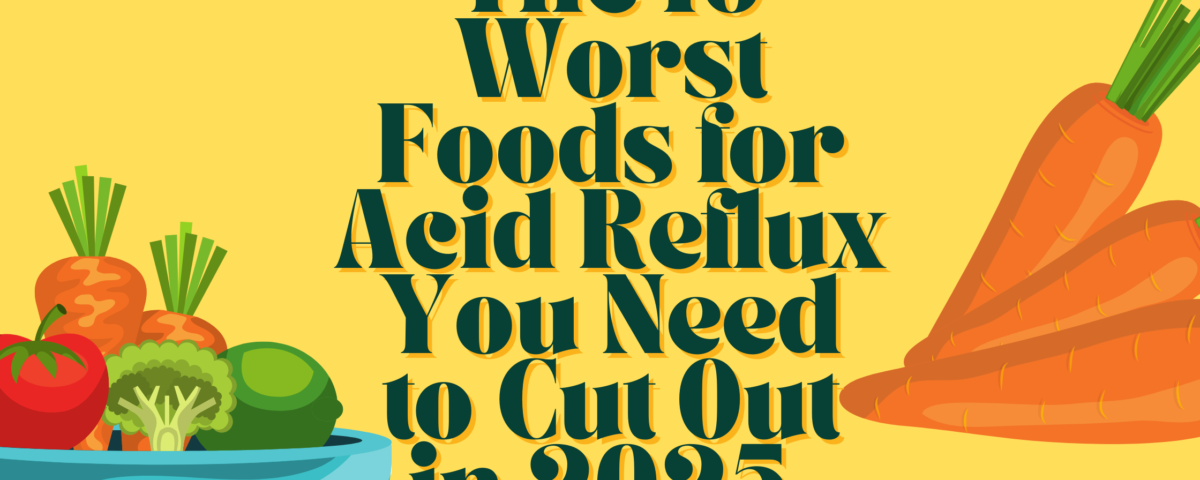Top 10 Acid Reflux Trigger Foods to Cut in 2025
Want a Healthier Liver? Here Are 6 Simple Ways to Detox Naturally!
April 9, 2025
The Ultimate Nutrition Plan for Naturally Glowing & Radiant Skin
June 12, 2025Acid reflux, also known as gastroesophageal reflux disease (GERD), is a common digestive issue that affects millions of people worldwide. It occurs when stomach acid backs up into the esophagus, causing uncomfortable symptoms like heartburn, regurgitation, chest pain, and even difficulty swallowing. While medications and lifestyle changes can help manage acid reflux, one of the most effective ways to reduce symptoms is by making careful choices about what you eat.
In 2025, it’s more important than ever to understand which foods can trigger or worsen acid reflux. By cutting out certain foods from your diet, you can take control of your condition and avoid those painful flare-ups. So, let’s dive into the 10 worst foods for acid reflux that you should be avoiding in the new year!
Common Symptoms of Acid Reflux
Before we explore the worst foods for acid reflux, let’s take a quick look at the symptoms you may experience:
Heartburn: A burning sensation in the chest, often after eating.
Regurgitation: Sour or bitter-tasting acid backing up into your throat or mouth.
Difficulty Swallowing: The feeling of food being stuck in your throat or chest.
Chronic Cough: A persistent cough without a clear cause.
Chest Pain: Pain in the chest, often mistaken for heart issues.
Sore Throat: Irritation or soreness in the throat due to acid exposure.
If you regularly experience any of these symptoms, it might be time to evaluate your diet and make some necessary changes.
While these factors play a role, your diet is one of the most controllable aspects of managing acid reflux. Now, let’s take a look at the 10 worst foods that can trigger or worsen acid reflux.
The 10 Worst Foods for Acid Reflux You Need to Cut Out in 2025
Citrus Fruits: High in acid, they can irritate the esophagus. Opt for low-acid fruits like bananas instead.
Tomatoes: These can increase stomach acid. Try pesto or olive oil-based sauces instead.
Spicy Foods: Hot peppers and curries can relax the LES, allowing acid to travel back up. Minimize spicy dishes.
Fried and Fatty Foods: These slow digestion and relax the LES, increasing the chance of reflux. Choose grilled or baked options.
Chocolate: Contains caffeine and theobromine, both of which relax the LES and slow digestion.
Mint and Peppermint: They can relax the LES and worsen symptoms. Try ginger or chamomile tea instead.
Onions and Garlic: They can increase stomach acid. Consider milder alternatives like chives or shallots.
Carbonated Beverages: The bubbles relax the LES and cause bloating. Stick to still water or herbal teas.
Alcohol: It relaxes the LES and increases stomach acid. Limit intake and avoid drinking on an empty stomach.
Caffeinated Drinks: Coffee, tea, and energy drinks increase acid production. Opt for decaf or herbal teas.
Foods That Help Reduce or Reverse Acid Reflux
In addition to avoiding trigger foods, here are some foods that can help soothe acid reflux:
Ginger: Known for its anti-inflammatory properties, it can help calm the stomach.
Bananas: Naturally low in acid, they help coat the stomach lining and reduce irritation.
Oatmeal: Absorbs stomach acid and is gentle on the digestive system.
Aloe Vera: Soothes the esophagus and reduces inflammation.
Leafy Greens: Low in acid, they promote digestion and overall health.
Melons: Alkaline and hydrating, they neutralize stomach acid.
Healthy Fats: Avocados and olive oil can reduce inflammation and support digestion.
Chamomile Tea: Calms the digestive system and reduces inflammation.
Fennel: Stimulates digestive enzymes and soothes the stomach.
Sweet Potatoes: Alkaline and fiber-rich, they help neutralize acid.
Conclusion
Acid reflux can significantly impact your quality of life, but making smart food choices can help alleviate symptoms and prevent flare-ups. By cutting out the 10 worst foods for acid reflux from your diet in 2025, you can improve your digestive health and enjoy a more comfortable life. If you’re struggling with managing acid reflux or need more personalized advice, consulting with a nutrition expert or a health nutritionist can help you develop a suitable eating plan to keep reflux under control.


